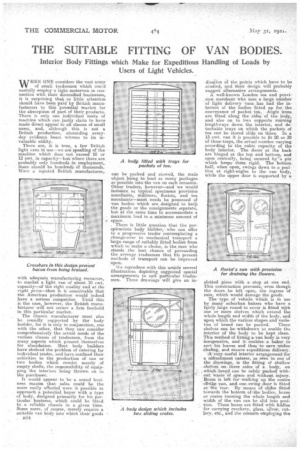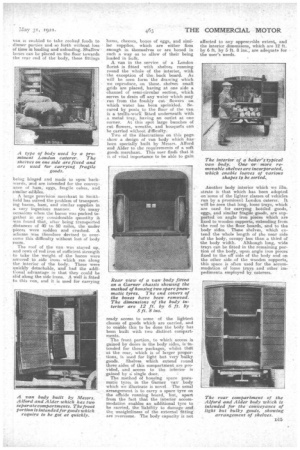THE SUITABLE FITTING OF VAN BODIES.
Page 16

Page 17

If you've noticed an error in this article please click here to report it so we can fix it.
Interior Body Fittings which Make for Expeditious Handling of Loads by Users of Light Vehicles.
WHEN ONE considers the vast army of small tradesmen which could usefully employ •a light motorvan in connection with their diversifiedbusinesses, it is surprising that, so little attention should have been paid by British manufacturers to this potential market for the absorption of part of their products. There is only one individual make of machine which can justly claim to have made direct appeal to all classes of small users, and, although this is not a British production, abounding everyday evidence bears witness to its invaluable utility. There are, it is true, a few British light vans in use—we are speaking of the machine which does not exceed 10 or 12 cwt. in capacity—but where there.are probably only hundreds.. in employment, there should be hundreds of thousands. Were a reputed British manufacturer, with adequate manufacturing resources, to market a light van of about 10 cwt. capacity—of the right anality and at the right price—then it is conceivable that the American production would indeed have a serious competitor. Until this is the case, however, the British manufacturer will not secure a firm foothold in this particular market.
The chassis manufacturer must also be soundly supported by the body builder, for it is only in conjunction, one with the other, that they can consider comprehensively the actual needs of the various classes of tradesmen, from the many aspects which present themselves for elucidation. Most body builders have shelved the problem of catering for individual trades, and have confined their activities to the production of one or two bodies which consist merely of empty shells, the responsibility of equipping the interiors being thrown on to the purchaser.
It would appear to be a sound business maxim that sales could be the more easily effected were it possible to approach a potential buyer with a type of body, designed primarily for his particular business, which could be fitted to a reliable chassis in a given time. Some users, of course, merelyrequire a suitable van body into which their goods D14
can be packed and stowed, the main object being to load as many packages as possible into the van on each occasion. Other traders, however—and we would instance as typical specimens provision merchants, milliners, -florists, and tea merchants—must needs be possessed of van bodies which are designed to keel') the goods or the consignments separate, but at the same time to accommodate a maximum load in a minimum amount of space.
, There is little question that the perspicacious body builder,who can offer to a progressive trader contemplating a change-over to mechanical transport a large range of suitably fitted bodies from which to make a choice, is the man who stands the best chance of persuading the average tradesman that his present methods of transport can be improved upon.
We reproduce with this article several illustrations depicting suggested special arrangements to suit particular tradesmen. These drawings will give an in dicailon Of the points which have to be studied, and their design will probably suggest alternative arrangements. A well-known London tea and provision merchant who uses a large number of light delivery vans has had the interiors of the bodies fitted up for the conveyance of packet tea. Angle irons are fitted along the sides of the body, and also on to two supports running lengthways down the interior, and detachable trays on which the packets of tea cart be stored slide on these. In a 15 cwt. van it is possible to fit 20 or 30 of these trays, the actual number varying according to the cubic capacity of the body interior. The doors at the back are hinged at the top and bottom, and open centrally, being secured by'a pin which keeps them rigid. The bottom half, when open, swings down to a position at right-angles to the van body, while the upper door is supported by a slotted piece with a stop at one end. This construction prevents, even though the doors be left open, the ingress of rain, which would damage the goods.
The type of vehicle which is in use by many suburban bakers who have a fairly large round to cover is fitted with one or more shelves which extend the whole length and width of the body, and upon which the various shapes and varie ties of bread can be packed. These shelves can be-withdrawn to enable the interior of the body to be kept clean. This method of fitting a van body is very inexpensive, and it enables a baker to sort his loaves and thus to save undue chafing, and ensure expeditious delivery.
:very useful interior arrangement for a refreshment caterer, as aeen in one of the drawings, is the fitting of shallow shelves ofi• three sides of a body, on which bread can be safely packed without waste of space and without. injury_ Room is left for -walking up the centre fitethe van, and one ,swing door is fitted at 'the 'rear. By -means of slides fitted towards the bottom of ,the bodies, boxes or crates running the whole length and width of the van can be slid into position. These boxes are fitted with fiddles for carrying crockery, glass, silver, cutlery, etc., and the concern employing the
van is enebled to take cooked foods to dinner parties and so forth without loss • of time in loading and unkadieg. Shallow boxes can be placed on the floor towards the rear end of the body, these fittings
being hinged and made to open backwarcte and are intended for the convey-. anee of ham,eggs, fragile cakes, arid similar edible.
A large provision merchant in Smithfield has solved the problem of transporting bacon, ham, and similar supplies in
a very ingenious manner. On many occasions when the bacon was peeked together in any considerable qtantity it was found -that, after being transported .distances of 40 to•50 miles, the under .pieces were sodden and crushed. A scheme was therefere devised to over.come this difficulty without loss of body room.'
The roof of the van was stayed up, and rows of rod iron of sufficient strength to take the weight of -the bacon were encored to side irons which ran along the interior of the body. These were quickly detachable, and had the additional advantage in that. they could be slid along the side irons. A well is fitted to this van, and it is used for carrying hams, cheeses, boxes of eggs, and similar supplies, which are either firm enough in themselves or are boxed in such a way as to allow of their being loaded in bulk.
A. van in the service of a London florist is fitted with shelves running round the whole of the interior, with the exception of the. back board. As will be seen form the drawing which we reproduce, on these. shelves small grids are placed, having at one side a channel of semi-circular section, which serves to drain off any water which may run from the freshly cut flowers on which water has been sprinkled. Secured by posts to the floor of the van is a trellis-v/4k fitted underneath with a metal tray, having an outlet at one corner. At this spot large bunches of cut flowers, wreaths, and bouquets can be carried without difficulty.
Two of the illustrations on this page. show a design of van body which has been specially built by Messrs. Alford and Alder to the requirements of a soft goods merchant. This user finds that. it is of vital importance to be able to gain ready access to some of the lightest classes of goods which are carried, and to enable this to be done the body has been built with two distinct compartments.
The front portion, to which access is gained by doors in the body sides, is %it-ended for these packages, whilst tha at the rear, which is of larger proportions, is used for light bet very bulky goods. Shelves which extend round three aides of this compartment are provided, and access to the interior is gained by a:single door.
The method of housing spare pneumatic tyres in the Garner vanbody which we illustrate is novel. The ustml arrangement is to carry a spare tyre on the offside running hoard, but, apart from the fact that the interior accommodation enables an additional tyre to be carried, the liability to damage and the unsightliness of the external fitting are overcome. The body capacity is not
affected to any appreciable extent, and the interior dimensions, which are 12 ft. by 6 ft. by 5 ft. 8 ins., are adequate for the user's needs.
Another body interior which we illustrate is that which has been adopted on some of the lighter classes of vehicles run by a prominent London caterer. It will be e-een that long, loose trays, which are need for carrying bottled goods, eggs, and similar fragile goods, are supported on angle iron pieces which are fixed to wooden supports, extending froth the roof to the floor hoards, and to the body sides. These shelves, which extend the whole length of the near side of the body, occupy less than a third of the body width. Although long, wide trays can be fitted in the remaining portion of the body, -upon angle iron pieces fixed to the off side of the body and on the other side. of the -Wooden supports, this space is often used for the accommodation of loose trays and other impedimenta, employed by caterers.










































